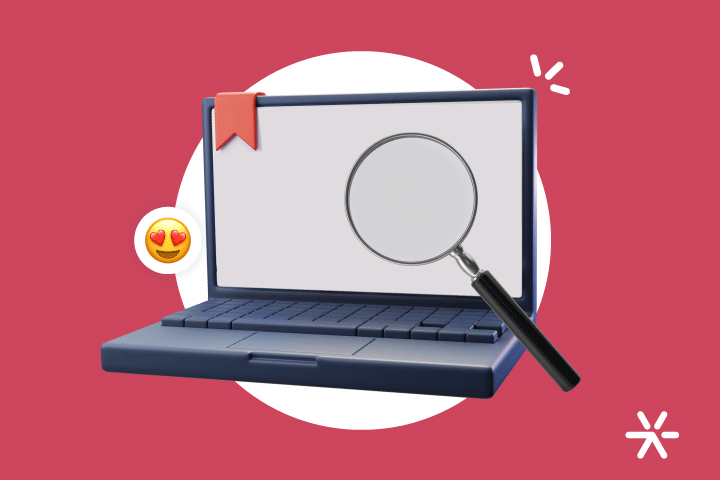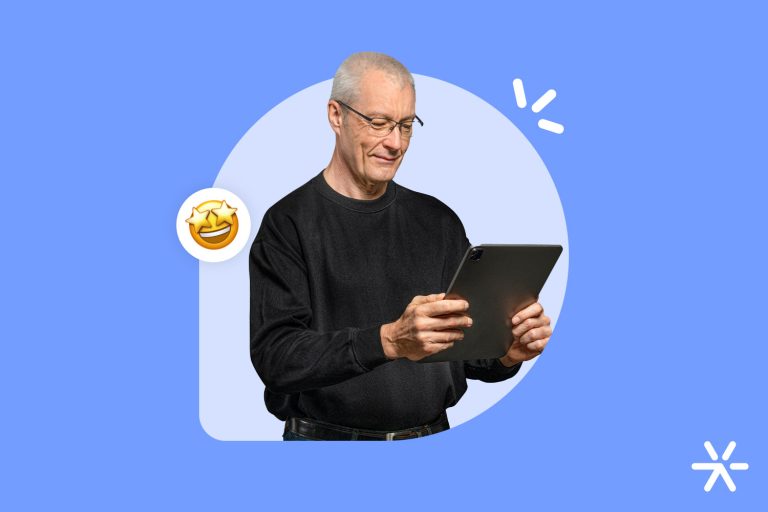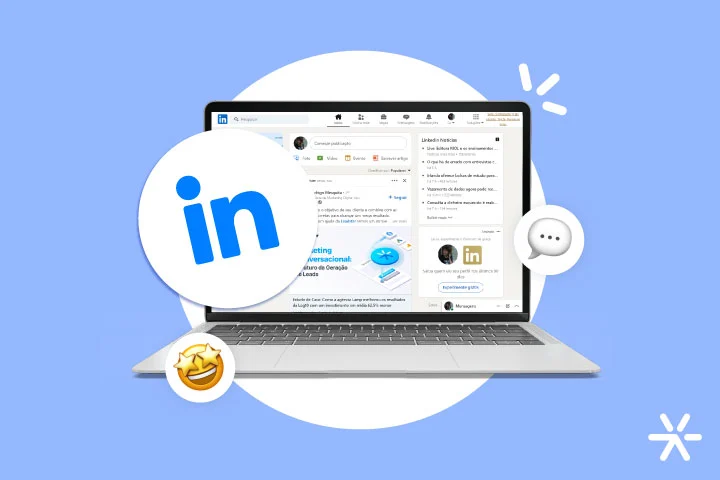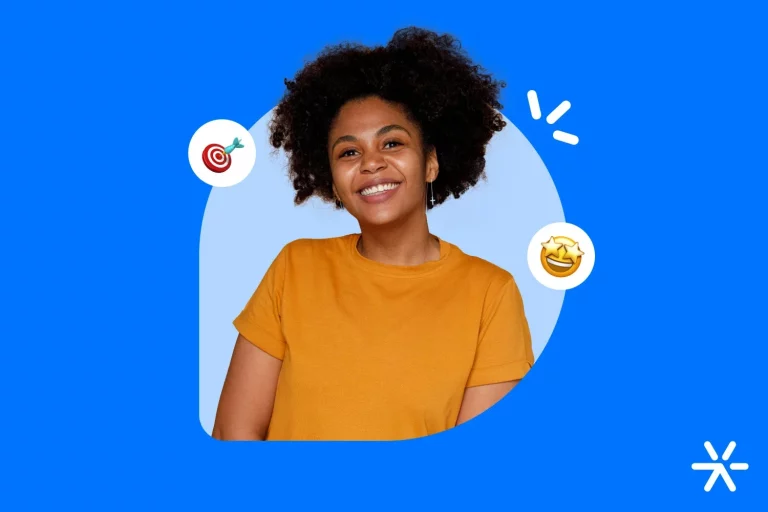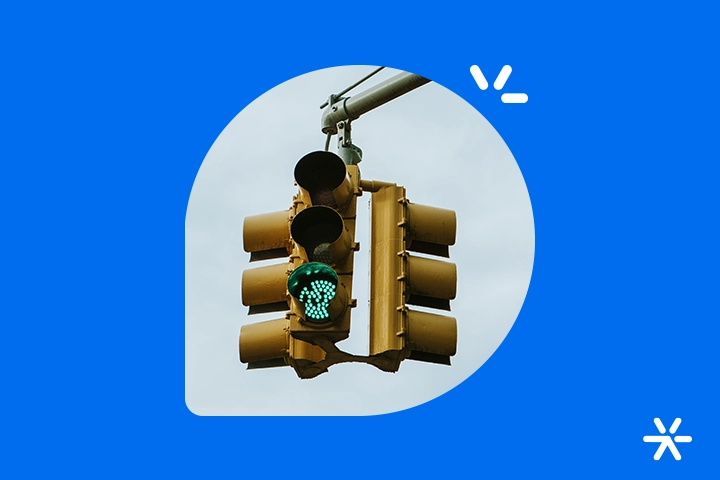What is a Landing Page? 7 Examples and How to Create One in Practice
Do you know what a landing page is? Even if you don’t know exactly what it is, it’s very likely that you’ve accessed one at least once in your life.
The popularity of landing pages exploded with the advancement of digital marketing based on the inbound methodology. Today, there are dozens of platforms that offer the creation of a landing page for anyone.
And that’s a major advancement – those who’ve been working in marketing for a long time will agree with me.
In the past, if you wanted to create an extra page on your website to offer some material, you would need someone with knowledge in website creation – via WordPress and using HTML.
Today, with the popularization of these tools, it’s possible to create landing pages with just a few clicks and a lot of creativity. And you can make them work with huge ease.
But it seems like I’m getting ahead of myself 😅 The article today is to talk more about what landing pages are, what their functions are, and to present you with 7 high-performance examples.
Let’s go?
What is a Landing Page?

Theoretically, every time you click on a link, you end up on a landing page – you’ve left one place and arrived at another destination.
But what digital marketing understands as a landing page is a bit different. It is a page used to deliver an offer or material in exchange for a quick registration of basic information, usually email, contact phone number, company size, and segment.
With an example, it will be easier. This is the landing page for our paid media planning material. You’ll notice that the structure of the page talks more about the material and why you should download it.
And by clicking the download button, we’ll ask for a few simple details – in this case, your name and email.
A landing page is that: a page that concentrates information about a certain product, offer, or material and makes it available for download in exchange for a few simple details.
What is a Landing Page For?
Well, the main function of a landing page is, as we have already seen, to make a material available for download, right?
But to truly understand what it does, we also need to talk about the platforms that create landing pages today – both paid and free.
Making a material available for download is simple, and you don’t even need an extra page for each material. A category on your website with some buttons would be enough, right?
The issue is that the landing page is used to capture leads. And when they are made through paid platforms – like RD Station, ActiveCampaign, HubSpot, etc. – they capture and organize the data and display of your leads with parameters that they determine.
🔎 Read more: How to generate sales leads and convert them better
But there are also ways to create a landing page directly via an open-source CRM, like WordPress. For that, you need the support of someone who already works with it, like a developer.
In this case, you would have to do the lead organization yourself. This is possible with tools like Leadster, which integrates with CRM and organizes the leads for you.
What the platforms and CRMs offer is a way to create the landing page, capture the leads, and store them well. This has become so popular that today we can say that these three points are the main functions of landing pages.
Is a Landing Page a Website?
Yes and no. A website, or as our Portuguese cousins would say, a “sítio,” is a page or set of pages that can be accessed on the internet. So, by definition, a landing page is a website.
But in digital marketing, there is a fundamental distinction between a landing page and a website that cannot be ignored.
What we normally call a website is a set of pages organized in categories sharing a single domain. This website can have landing pages within it, which also share the domain.
Landing pages are single pages with a specific purpose – lead capture. Sometimes, landing pages are created before the website to launch a product and serve as the primary form of contact with the brand.
So, landing pages are technically a website, but simpler, with just one page and a single purpose – make contact, download some material, reserve a product, etc.
When to Create a Landing Page?
There are several situations when you need to create a landing page. We’ve already mentioned a few in the previous sections.
Usually, a landing page is created when you are looking to capture more leads. Visitors download the material you made available by leaving their contact information, and they become leads.
But this isn’t the only purpose of a landing page. Websites that are launching new products can create a landing page to organize reservations for them.
Some e-commerce businesses also start their sales through a landing page before setting up their sales structure, usually when the products are already available, and the website will take some time to be ready.
So, the purposes of a landing page are many, but usually, you will need to create one when you need to capture leads or when you want to make sales and reservations for a new product.
How to Create a Landing Page?
A landing page can be made in several ways, but the most popular methods are by using WordPress or directly on a lead capture and landing page creation platform.
With WordPress, it’s more challenging, but you have much greater control over the page’s aesthetics, can include HTML and JavaScript code, and have more freedom to install plugins. Essentially, you have total control over the page’s source code.
On marketing automation platforms, the work is simpler, and you already have a lead capture and organization tool. But the code is generated by the platform itself, and you can’t directly modify it.
Here’s more about how to make a landing page using WordPress and specific tools:
How to Create a Simple Conversational Landing Page
Did you know you can create a capture page using Leadster in 5 minutes?
Check out this link to see how it works in practice. Building it is a simple task when you already have Leadster as a conversational marketing platform.
Basically, you just create your flow and use the link our platform generates. The result is a simple landing page, with the chatbot asking the questions you’ve set up.
This Leadster capture page is for moments when you need to launch your material quickly, or for situations that don’t require a very complex landing page – like the link in your Instagram bio.
Watch more about how it works in this video:
How to Create a Landing Page on WordPress
If you already have a site on WordPress, the first step is to create a new page. There’s a menu on the left side that allows you to do this.
Next, you’ll need to actually create the page. The easiest way is to find a free template to use on the page and then edit it according to your needs and knowledge.
WordPress now uses the block editor, so basically, you just add blocks one by one, adjust their appearance in the left-hand menu, and add your text.
But I highly recommend using a free template. They give your landing page a completely fresh look, and even though they might initially be hard to edit, you’ll get the hang of it quickly and will be able to make many different changes.
How to Create Landing Pages Using Platforms
There are several platforms that allow you to create landing pages. The most popular ones today are HubSpot and ActiveCampaign.
Both allow for image uploads, text editing, creation of static forms, and organization of blocks and lines in a drag-and-drop style – click and drag.
Both are very simple and intuitive; anyone can use them. The challenge is explaining how they work without you having access to them.
Let’s do this: see below a video showing how the tool works.
🔎 Also read: 16 Best Landing Page Tools to Generate Leads
4 Steps to Create a High-Converting Landing Page
A high-converting landing page uses several digital marketing techniques to stand out.
The key here is this word: stand out. The internet is like a huge avenue lined with stores, each more interesting than the last. Users walk down this avenue and stop at the ones that attract them the most.
The thing is, this avenue is endless, and there are hundreds of thousands of stores on each block. How do you make your corner more attractive than your competitors?
We’ll show some techniques here that will really help you get that attention. Starting with the basics:
Target Audience Research for Your Landing Page
This is the first step you need to take before building your landing page. You probably already have a target audience study and personas built, right?
If you don’t, I recommend reading our article on buyer personas and brand personas. It explains step by step what you need to do.
But pay attention: every landing page works with a specific offer. You need to understand if what you’re offering requires a specific argument for your audience.
One example: here at Leadster, we work with conversational marketing and have a persona focused on agencies. We built a landing page to promote paid media material.
All good – the persona matches the material. But what does the material represent for the persona? How will it help her in her daily life? To answer this question, you need to read the material and understand where it fits into my target audience’s routine.
And of course: present all this information concisely and persuasively. We talk more about this in the copywriting section.
You’ll need to understand the same thing. Study the offer. Find key points that will help you with conversions. That way, it will be much easier to determine what to say on the landing page.
And speaking of the offer:
Determine the Best Offer for the Landing Page
Many people think digital marketing is defined by positioning. The more resources you have, the more places you appear, the better.
That’s true, but digital marketing isn’t defined by that. There’s still a legacy from traditional marketing that never goes away: your brand is as attractive as the product it offers.
The same applies to our case – your success is closely tied to the quality and relevance of what you’re offering on your landing page.
So, even if your landing page design is amazing, even if the text is perfect, what will determine its success is what you’re offering.
One of the tasks of identifying your personas is exactly understanding what they would like to receive. What will make their life easier. This is crucial when building a landing page.
🔎 Also read: Google Analytics 4 - how to access, configure, and use it
Write the Best Copy for the Landing Page

Good copy for landing pages doesn’t have many secrets if you’ve already completed all the previous steps.
Really. There are several books on persuasive writing from the greatest legends of copywriting, and if you read them, you’ll find basically what we’re saying here in all of them.
If you know your product and your audience, the copy for your landing page will flow naturally. You just need to consider its structure: this is the main part.
To help you, here’s how to structure the content of a landing page:
- At the top of the page: a short copy that speaks directly about how your material/product will solve your persona’s problem. Something like “20 minutes of reading and you’ll set up your paid media by yourself.” Don’t forget to include a download button before the first fold of the page.
- In the second section: include a larger text and a screenshot of your material’s interior or more photos of the product. This is where you explain what you’re offering, who the material/product helps, and why.
- In the third section: quick points explaining what your material or product has. Choose five and write a short text, no more than 5 words, for each one. Something like “Practical examples,” “Made by professionals,” etc. Don’t forget that these promises need to be kept!
- In the fourth section: testimonials from people who have read the material, if possible, or from the experts who developed it. For products, this is easier to get.
- In the fifth section: another persuasive and interesting text, similar to the top of the page, including a final CTA.
Normally, landing pages end with a registration form, but studies show that this form ends up hindering many conversions.
We recommend a chatbot for finalizing the conversion, which is super easy to set up. 😎
Design for Landing Pages
We left the design of landing pages for last because typically the text comes first before the design. But it doesn’t have to be that way!
In fact, it’s quite interesting for the UX team to create a sketch first and ask the copywriting team to fill it in with the text. Then, it’s just a matter of adjusting.
The key to consider in the design of landing pages is never leaving the reader lost, not knowing what to do.
Buttons should be present on every fold of the page, always presenting an action that can be taken at any time.
It’s also very common for landing pages to become overloaded with information. This is unnecessary and can actually harm you quite a bit.
When the offer is suitable for your target audience, you don’t need to add too much to your landing page – remember to always let the material or product speak for itself.
The more white space, the easier it will be to read your landing page.
🔎 Dive deeper into the topic: 15 Steps to Create a High-Converting Landing Page + Free Checklist
How to Create a Conversational Landing Page?
You noticed that we’re advocates of the conversational landing page throughout the article. But perhaps we haven’t really discussed the true reason why we use this model for all the landing pages we create.
We’ve already said it converts more, right? But it’s a bit more than that: the conversational landing page allows for much closer engagement with our target audience. And that has tremendous value.
We don’t just want you to download our material, test our platform, and so on. We genuinely want to help you. And we need to convey that in everything we do.
And, of course: we want you to convert more. And the era of forms is coming to an end.
Having a conversational landing page is very simple. By activating Leadster on your site, you configure the messages , set it up on your landing page, and voila – it’s working.
By the way, why not try it today? See how to create a free chatbot with Leadster now and transform your landing pages for the better!


